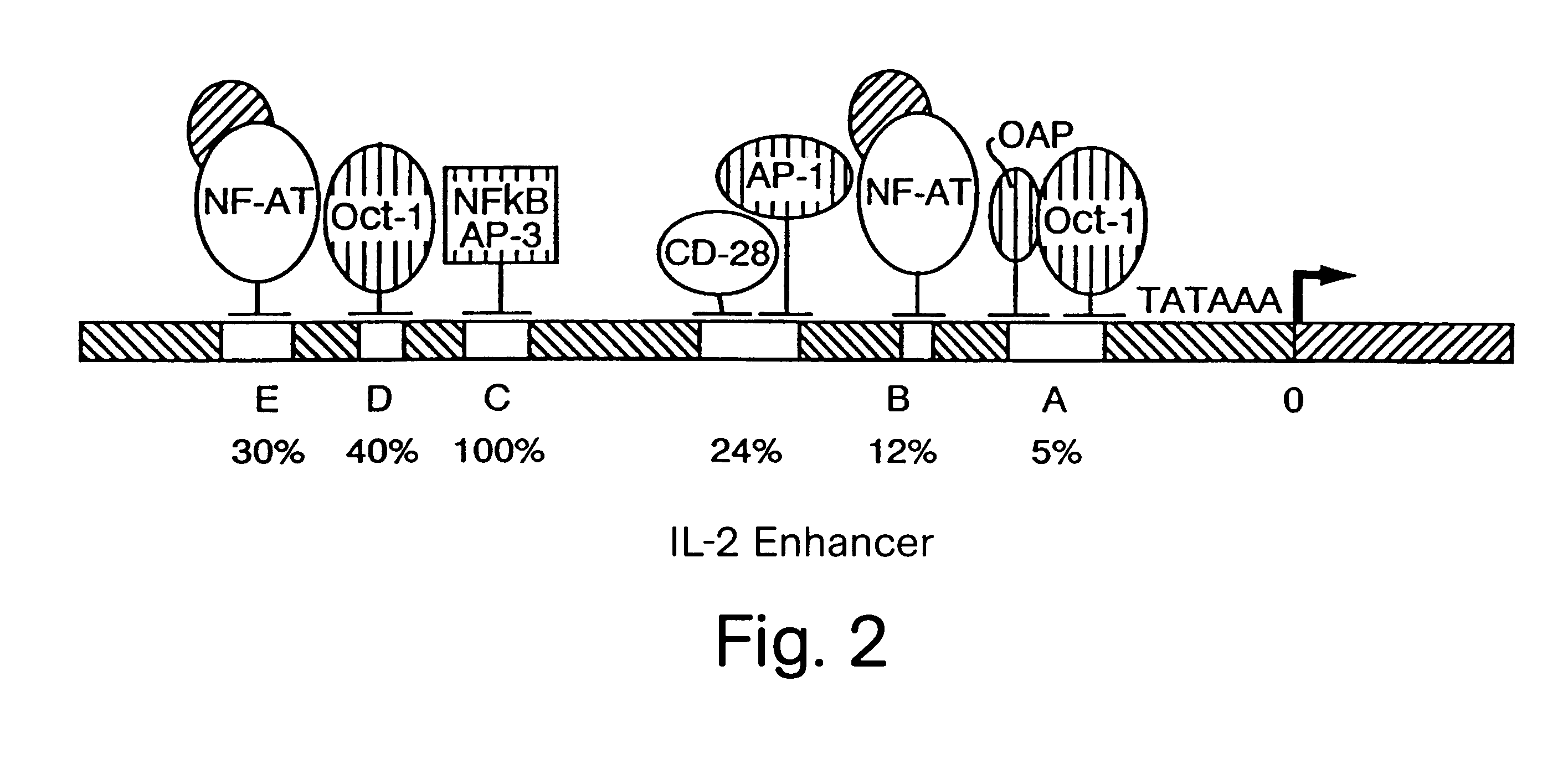NF-AT polypeptides and polynucleotides and screening methods for immunosuppressive agents
- Summary
- Abstract
- Description
- Claims
- Application Information
AI Technical Summary
Benefits of technology
Problems solved by technology
Method used
Image
Examples
experimental examples
Example 1
NF-AT is Enriched in Activated T Cells
A DNA binding assay was used to determine the amount of NF-AT present in nuclear extracts from several stimulated and unstimulated cell lines. A radiolabelled oligonucleotide probe corresponding to the NF-AT binding site was hybridized to concentrated nuclear extracts to determine the amount of NF-AT DNA binding activity present.
Procedure
Nuclear extracts were made according to the procedures of Ohlsson and Edlund (Cell 45:35 (1986)). Briefly, nuclei were extracted with 0.3 M (NH.sub.4).sub.2 SO.sub.4 and the fraction that contained the nuclear proteins was precipitated with 0.2 g / ml (NH.sub.4).sub.2 SO.sub.4 and dialyzed for 4 h. at 4.degree. C. The NF-AT binding site of the IL-2 enhancer (-290 and -263) was used as a probe for binding activity. The binding experiment was carried out essentially as described in Shaw, J. P. Science 241:202-205 (1988)).
Results
As shown in FIG. 4, using a simple gel mobility shift assay, a complex forms wit...
example 2
Protein Synthesis is Required for Production of the Nuclear Component of the NF-AT Complex, While the Cytoplasmic Component is Preexisting
To determine whether protein synthesis is required for formation of the nuclear and cytoplasmic components of the NF-AT complex, or whether the proteins are constitutively present in the cells, an NF-AT-specific DNA binding assay was done using NF-AT complex that had been reconstituted from nuclear and cytoplasmic extracts from cells that had been activated in the presence or absence of a protein synthesis inhibitor.
Procedure
NFATZ Jurkat cells were pretreated with 100 .mu.M anisoymycin (Sigma), a protein synthesis inhibitor, for 30 minutes before stimulating the cells. Conditions for activating the cells and preparing nuclear and cytoplasmic extracts are described in Example 3.
Results
As shown in FIG. 5, the protein synthesis inhibitor completely blocked the appearance of the NF-AT complex in activated T cells (Lanes 2,4,6). This demonstrates that ...
example 3
NF-AT Can Be Reconstituted from Cytosolic and Nuclear Subunits
A possible interpretation of the data presented in FIG. 5 is that NF-AT is synthesized but sequestered or compartmentalized within the cell and upon breakage of the cells some transcriptionally active NF-AT is formed. To test this hypothesis, the DNA binding ability of NF-AT complexes reconstituted from cytosolic and nuclear extracts from stimulated and non-stimulated T cells, as well as from cells that had been treated with FK506 just prior to stimulation was tested.
Procedure
NFATZ Jurkat cells and JK12 / 90.1 cells (a gift from N. Shastri) were stimulated for 2 hours with 20 ng / ml PMA and 2 .mu.M ionomycin. To quantitatively block NF-AT formation, FK506 100 ng / ml or CsA (Sandoz) 500 ng / ml were used five minutes prior to the addition of PMA and ionomycin, without any toxic effects to the cells. Nuclear extracts were prepared as described previously with modifications. Cytoplasmic extracts were made from the same cells as th...
PUM
| Property | Measurement | Unit |
|---|---|---|
| Angle | aaaaa | aaaaa |
| Cell death | aaaaa | aaaaa |
| Transport properties | aaaaa | aaaaa |
Abstract
Description
Claims
Application Information
 Login to View More
Login to View More - R&D
- Intellectual Property
- Life Sciences
- Materials
- Tech Scout
- Unparalleled Data Quality
- Higher Quality Content
- 60% Fewer Hallucinations
Browse by: Latest US Patents, China's latest patents, Technical Efficacy Thesaurus, Application Domain, Technology Topic, Popular Technical Reports.
© 2025 PatSnap. All rights reserved.Legal|Privacy policy|Modern Slavery Act Transparency Statement|Sitemap|About US| Contact US: help@patsnap.com



